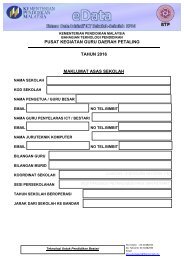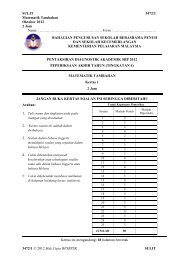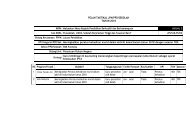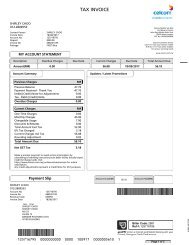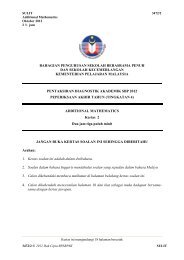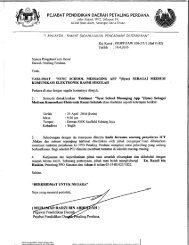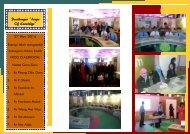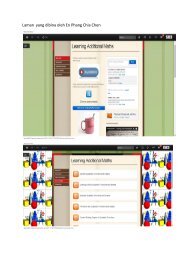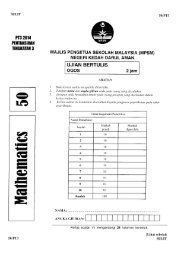Download File
Create successful ePaper yourself
Turn your PDF publications into a flip-book with our unique Google optimized e-Paper software.
May 6, 2016<br />
TRADER NEWS<br />
Northwind Traders Newsletter<br />
In this issue:<br />
Advantages of a<br />
Newsletter<br />
Add Value to Your<br />
Newsletter<br />
Second Story<br />
Another Story<br />
Back Page Story<br />
Advantages of a<br />
Newsletter<br />
The purpose of a newsletter is to provide<br />
specialized information to a targeted audience.<br />
Newsletters can be a great way to market your<br />
product or service, and also create credibility and<br />
build awareness for you and the services you<br />
provide. Use positive customer pull-quote and eye<br />
-catching but subtle marketing.<br />
Tips for Producing a Newsletter<br />
Every time you produce your newsletter, ask<br />
yourself:<br />
Q: Who are our readers?<br />
A: Existing customers and potential customers.<br />
Q: What will our readers want to know about<br />
our business?<br />
A: Timely, helpful, problem-solving information.<br />
Add Value to Your Newsletter<br />
Keep you content as current a possible. If you<br />
publish a monthly letter, ensure you include<br />
content from only the last month. Also, use<br />
photographs and other visuals to add interest and<br />
enable the reader to scan quickly for information.<br />
“Customer quotes,<br />
called “pull quotes,”<br />
are an excellent way<br />
to demonstrate your<br />
success and put<br />
emphasis on your<br />
values. They also add<br />
visual interest to your<br />
newsletter…”<br />
-Raffaella Bonaldi<br />
Photo Caption
Your Organization<br />
Newsletter Date<br />
Volume 1, Issue 1<br />
Newsletter Title<br />
LEAD STORY HEADLINE<br />
This story can fit 175-225 words.<br />
The purpose of a newsletter is to provide specialized information to a targeted audience.<br />
Newsletters can be a great way to market your product or service, and also create<br />
credibility and build your organization’s identity among peers, members, employees, or<br />
vendors.<br />
First, determine the audience of the newsletter. This could be anyone who might benefit<br />
from the information it contains, for example, employees or people interested in<br />
purchasing a product or requesting your service.<br />
You can compile a mailing list from business reply cards, customer information sheets,<br />
business cards collected at trade shows, or membership lists. You might consider<br />
purchasing a mailing list from a company.<br />
If you explore the Publisher catalog, you will find many publications that match the style<br />
of your newsletter.<br />
Next, establish how much time and money you can spend on your newsletter. These<br />
factors will help determine how frequently you publish the newsletter and its length. It’s<br />
recommended that you publish your newsletter at least quarterly so that it’s considered a<br />
consistent source of information. Your customers or employees will look forward to its<br />
arrival.<br />
SECONDARY STORY HEADLINE<br />
This story can fit 75-125 words.<br />
Your headline is an important part of the newsletter and should be considered carefully.<br />
In a few words, it should accurately represent the contents of the story and draw readers<br />
into the story. Develop the headline before you write the story. This way, the headline will<br />
help you keep the story focused.<br />
Examples of possible headlines include Product Wins Industry Award, New Product Can<br />
Save You Time!, Membership Drive Exceeds Goals, and New Office Opens Near You.<br />
INSIDE THIS ISSUE<br />
Inside Story ..............................2<br />
Inside Story ..............................2<br />
Inside Story ..............................3<br />
Inside Story ..............................3<br />
Inside Story ..............................4<br />
Inside Story ..............................4<br />
Inside Story ..............................4<br />
SPECIAL POINTS OF<br />
INTEREST<br />
Briefly highlight your point<br />
of interest here.<br />
Briefly highlight your point<br />
of interest here.<br />
Briefly highlight your point<br />
of interest here.<br />
Briefly highlight your point<br />
of interest here.
INSIDE STORY HEADLINE<br />
This story can fit 150-200 words.<br />
One benefit of using your newsletter as a<br />
promotional tool is that you can reuse<br />
content from other marketing materials,<br />
such as press releases, market studies, and<br />
reports.<br />
While your main goal of distributing a<br />
newsletter might be to sell your product or<br />
service, the key to a successful newsletter<br />
is making it useful to your readers.<br />
A great way to add useful content to your<br />
newsletter is to develop and write your<br />
own articles, or include a calendar of<br />
upcoming events or a special offer that<br />
promotes a new product.<br />
You can also research articles or find<br />
“filler” articles by accessing the World<br />
Wide Web. You can write about a variety<br />
of topics but try to keep your articles<br />
short.<br />
Much of the content you put in your<br />
newsletter can also be used for your Web<br />
site. Microsoft Publisher offers a simple<br />
way to convert your newsletter to a Web<br />
publication. So, when you’re finished<br />
writing your newsletter, convert it to a<br />
Web site and post it.<br />
“To catch the reader's attention, place an interesting sentence or quote<br />
from the story here.”<br />
INSIDE STORY<br />
HEADLINE<br />
This story can fit 75-125 words.<br />
Selecting pictures or graphics is an<br />
important part of adding content<br />
to your newsletter.<br />
Think about your article and ask<br />
yourself if the picture supports or<br />
enhances the message you’re<br />
trying to convey. Avoid selecting<br />
images that appear to be out of<br />
context.<br />
Microsoft Publisher includes<br />
thousands of clip art images from<br />
which you can choose and import<br />
into your newsletter. There are<br />
also several tools you can use to<br />
draw shapes and symbols.<br />
Once you have chosen an image,<br />
place it close to the article. Be sure<br />
to place the caption of the image<br />
near the image.<br />
INSIDE STORY HEADLINE<br />
This story can fit 100-150 words.<br />
The subject matter that appears in newsletters is virtually endless. You can include stories<br />
that focus on current technologies or innovations in your field.<br />
You may also want to note business or economic trends, or make predictions for your<br />
customers or clients.<br />
If the newsletter is distributed internally, you might comment upon new procedures or<br />
improvements to the business. Sales figures or earnings will show how your business is<br />
growing.<br />
Some newsletters include a column that is updated every issue, for instance, an advice<br />
column, a book review, a letter from the president, or an editorial. You can also profile<br />
new employees or top customers or vendors.<br />
This story can fit 100-150 words.<br />
The subject matter that appears in newsletters is virtually endless. You can include stories<br />
that focus on current technologies or innovations in your field.<br />
You may also want to note business or economic trends, or make predictions for your<br />
customers or clients.<br />
If the newsletter is distributed internally, you might comment upon new procedures or<br />
improvements to the business. Sales figures or earnings will show how your business is<br />
growing.<br />
Some newsletters include a column that is updated every issue, for instance, an advice<br />
column, a book review, a letter from the president, or an editorial. You can also profile<br />
new employees or top customers or vendors.<br />
2
INSIDE STORY<br />
HEADLINE<br />
This story can fit 150-200 words.<br />
One benefit of using your<br />
newsletter as a promotional tool is<br />
that you can reuse content from<br />
other marketing materials, such as<br />
press releases, market studies, and<br />
reports.<br />
While your main goal of<br />
distributing a newsletter might be<br />
to sell your product or service, the<br />
key to a successful newsletter is<br />
making it useful to your readers.<br />
A great way to add useful content<br />
to your newsletter is to develop<br />
and write your own articles, or<br />
include a calendar of upcoming<br />
events or a special offer that<br />
promotes a new product.<br />
Caption describing picture or graphic<br />
INSIDE STORY HEADLINE<br />
This story can fit 150-200 words.<br />
One benefit of using your newsletter as a promotional tool is that you can reuse content<br />
from other marketing materials, such as press releases, market studies, and reports.<br />
While your main goal of distributing a newsletter might be to sell your product or service,<br />
the key to a successful newsletter is making it useful to your readers.<br />
You can also research articles or<br />
find “filler” articles by accessing<br />
the World Wide Web. You can<br />
write about a variety of topics but<br />
try to keep your articles short.<br />
Much of the content you put in<br />
your newsletter can also be used<br />
for your Web site. Microsoft<br />
Publisher offers a simple way to<br />
convert your newsletter to a Web<br />
publication. So, when you’re<br />
finished writing your newsletter,<br />
convert it to a Web site and post it.<br />
A great way to add useful content to your newsletter is to develop and write your own<br />
articles, or include a calendar of upcoming events or a special offer that promotes a new<br />
product.<br />
You can also research articles or find “filler” articles by accessing the World Wide Web.<br />
You can write about a variety of topics but try to keep your articles short.<br />
Much of the content you put in your newsletter can also be used for your Web site.<br />
Microsoft Publisher offers a simple way to convert your newsletter to a Web publication.<br />
So, when you’re finished writing your newsletter, convert it to a Web site and post it.<br />
This story can fit 100-150 words.<br />
The subject matter that appears in newsletters is virtually endless. You can include stories<br />
that focus on current technologies or innovations in your field.<br />
You may also want to note business or economic trends, or make predictions for your<br />
customers or clients.<br />
If the newsletter is distributed internally, you might comment upon new procedures or<br />
improvements to the business. Sales figures or earnings will show how your business is<br />
growing.<br />
Some newsletters include a column that is updated every issue, for instance, an advice<br />
column, a book review, a letter from the president, or an editorial. You can also profile<br />
new employees or top customers or vendors.<br />
3
INSIDE STORY<br />
HEADLINE<br />
This story can fit 75-125 words.<br />
Selecting pictures or graphics is an<br />
important part of adding content<br />
to your newsletter.<br />
Think about your article and ask<br />
yourself if the picture supports or<br />
enhances the message you’re<br />
trying to convey. Avoid selecting<br />
images that appear to be out of<br />
context.<br />
Microsoft Publisher includes<br />
thousands of clip art images from<br />
which you can choose and import<br />
into your newsletter. There are<br />
also several tools you can use to<br />
draw shapes and symbols.<br />
Once you have chosen an image,<br />
place it close to the article. Be sure<br />
to place the caption of the image<br />
near the image.<br />
INSIDE STORY HEADLINE<br />
This story can fit 150-200 words.<br />
One benefit of using your newsletter as a<br />
promotional tool is that you can reuse<br />
content from other marketing materials,<br />
such as press releases, market studies, and<br />
reports.<br />
While your main goal of distributing a<br />
newsletter might be to sell your product or<br />
service, the key to a successful newsletter<br />
is making it useful to your readers.<br />
A great way to add useful content to your<br />
newsletter is to develop and write your<br />
own articles, or include a calendar of<br />
upcoming events or a special offer that<br />
promotes a new product.<br />
You can also research articles or find<br />
“filler” articles by accessing the World<br />
Wide Web. You can write about a variety<br />
of topics but try to keep your articles<br />
short.<br />
Much of the content you put in your<br />
newsletter can also be used for your Web<br />
site. Microsoft Publisher offers a simple<br />
way to convert your newsletter to a Web<br />
publication. So, when you’re finished<br />
writing your newsletter, convert it to a<br />
Web site and post it.<br />
Caption describing picture or graphic<br />
INSIDE STORY HEADLINE<br />
This story can fit 75-125 words.<br />
Selecting pictures or graphics is an important part of adding content to your newsletter.<br />
Think about your article and ask yourself if the picture supports or enhances the message<br />
you’re trying to convey. Avoid selecting images that appear to be out of context.<br />
Microsoft Publisher includes thousands of clip art images from which you can choose and<br />
import into your newsletter. There are also several tools you can use to draw shapes and<br />
symbols.<br />
Once you have chosen an image, place it close to the article. Be sure to place the caption<br />
of the image near the image.<br />
INSIDE STORY HEADLINE<br />
This story can fit 100-150 words.<br />
The subject matter that appears in newsletters is virtually endless. You can include stories<br />
that focus on current technologies or innovations in your field.<br />
You may also want to note business or economic trends, or make predictions for your<br />
customers or clients.<br />
If the newsletter is distributed internally, you might comment upon new procedures or<br />
improvements to the business. Sales figures or earnings will show how your business is<br />
growing.<br />
Some newsletters include a column that is updated every issue, for instance, an advice<br />
column, a book review, a letter from the president, or an editorial. You can also profile<br />
new employees or top customers or vendors.<br />
4
INSIDE STORY HEADLINE<br />
This story can fit 100-150 words.<br />
The subject matter that appears in newsletters is virtually endless. You can include stories<br />
that focus on current technologies or innovations in your field.<br />
You may also want to note business or economic trends, or make predictions for your<br />
customers or clients.<br />
If the newsletter is distributed internally, you might comment upon new procedures or<br />
improvements to the business. Sales figures or earnings will show how your business is<br />
growing.<br />
Some newsletters include a column that is updated every issue, for instance, an advice<br />
column, a book review, a letter from the president, or an editorial. You can also profile<br />
new employees or top customers or vendors.<br />
“To catch the reader's attention, place an interesting sentence or quote<br />
from the story here.”<br />
INSIDE STORY HEADLINE<br />
This story can fit 150-200 words.<br />
One benefit of using your newsletter as a<br />
promotional tool is that you can reuse<br />
content from other marketing materials,<br />
such as press releases, market studies, and<br />
reports.<br />
While your main goal of distributing a<br />
newsletter might be to sell your product or<br />
service, the key to a successful newsletter<br />
is making it useful to your readers.<br />
A great way to add useful content to your<br />
newsletter is to develop and write your<br />
own articles, or include a calendar of<br />
upcoming events or a special offer that<br />
promotes a new product.<br />
You can also research articles or find<br />
“filler” articles by accessing the World<br />
Wide Web. You can write about a variety<br />
of topics but try to keep your articles<br />
short.<br />
This story can fit 100-150 words.<br />
The subject matter that appears in<br />
newsletters is virtually endless. You can<br />
include stories that focus on current<br />
technologies or innovations in your field.<br />
You may also want to note business or<br />
economic trends, or make predictions for<br />
your customers or clients.<br />
If the newsletter is distributed internally,<br />
you might comment upon new procedures<br />
or improvements to the business. Sales<br />
figures or earnings will show how your<br />
business is growing.<br />
Some newsletters include a column that is<br />
updated every issue, for instance, an<br />
advice column, a book review, a letter<br />
from the president, or an editorial. You<br />
can also profile new employees or top<br />
customers or vendors.<br />
Much of the content you put in your<br />
newsletter can also be used for your Web<br />
site. Microsoft Publisher offers a simple<br />
way to convert your newsletter to a Web<br />
publication. So, when you’re finished<br />
writing your newsletter, convert it to a<br />
Web site and post it.<br />
5
YOUR ORGANIZATION<br />
This would be a good place to<br />
insert a short paragraph about<br />
your organization. It might<br />
include the purpose of the<br />
organization, its mission, founding<br />
date, and a brief history. You<br />
could also include a brief list of the<br />
types of products, services, or<br />
programs your organization offers,<br />
the geographic area covered (for<br />
example, western U.S. or<br />
European markets), and a profile<br />
of the types of customers or<br />
members served.<br />
It would also be useful to include a<br />
contact name for readers who<br />
want more information about the<br />
organization.<br />
BACK PAGE STORY HEADLINE<br />
This story can fit 175-225 words.<br />
If your newsletter is folded and mailed, this story will appear on the back. So, it’s a good<br />
idea to make it easy to read at a glance.<br />
A question and answer session is a good way to quickly capture the attention of readers.<br />
You can either compile questions that you’ve received since the last edition or you can<br />
summarize some generic questions that are frequently asked about your organization.<br />
A listing of names and titles of managers in your organization is a good way to give your<br />
newsletter a personal touch. If your organization is small, you may want to list the names<br />
of all employees.<br />
If you have any prices of standard products or services, you can include a listing of those<br />
here. You may want to refer your readers to any other forms of communication that<br />
you’ve created for your organization.<br />
You can also use this space to remind readers to mark their calendars for a regular event,<br />
such as a breakfast meeting for vendors every third Tuesday of the month, or a biannual<br />
charity auction.<br />
If space is available, this is a good place to insert a clip art image or some other graphic.<br />
Your Organization<br />
Primary Business Address<br />
Your Address Line 2<br />
Your Address Line 3<br />
Your Address Line 4<br />
Phone: 555-555-5555<br />
Fax: 555-555-5555<br />
E-mail: someone@example.com<br />
PLEASE<br />
PLACE<br />
STAMP<br />
HERE<br />
Mailing Address Line 1<br />
Mailing Address Line 2<br />
Mailing Address Line 3<br />
Mailing Address Line 4<br />
Mailing Address Line 5<br />
YOUR LOGO<br />
HERE




